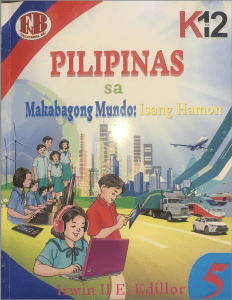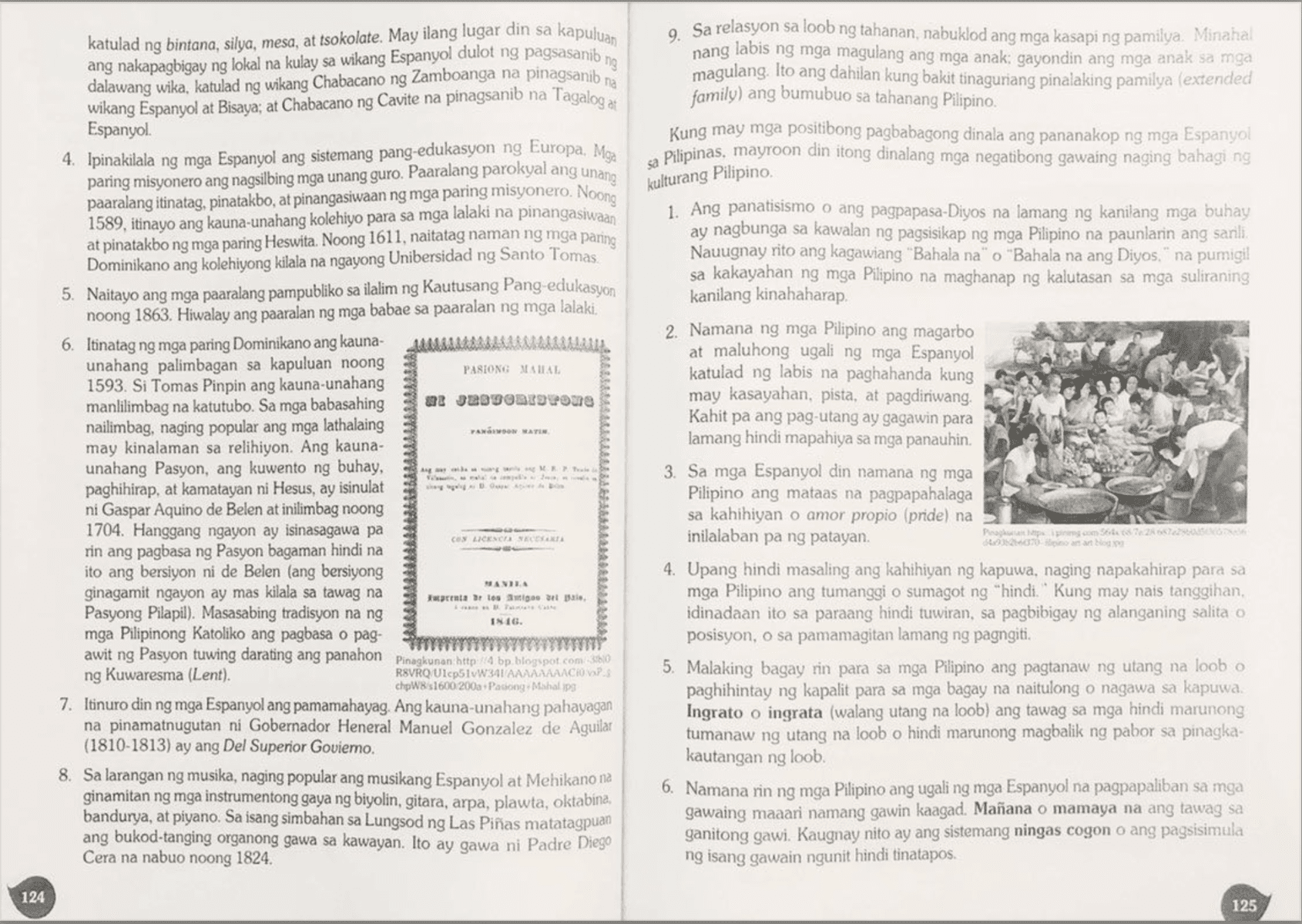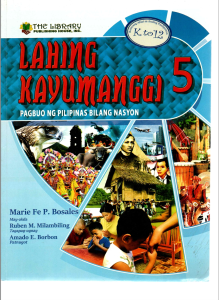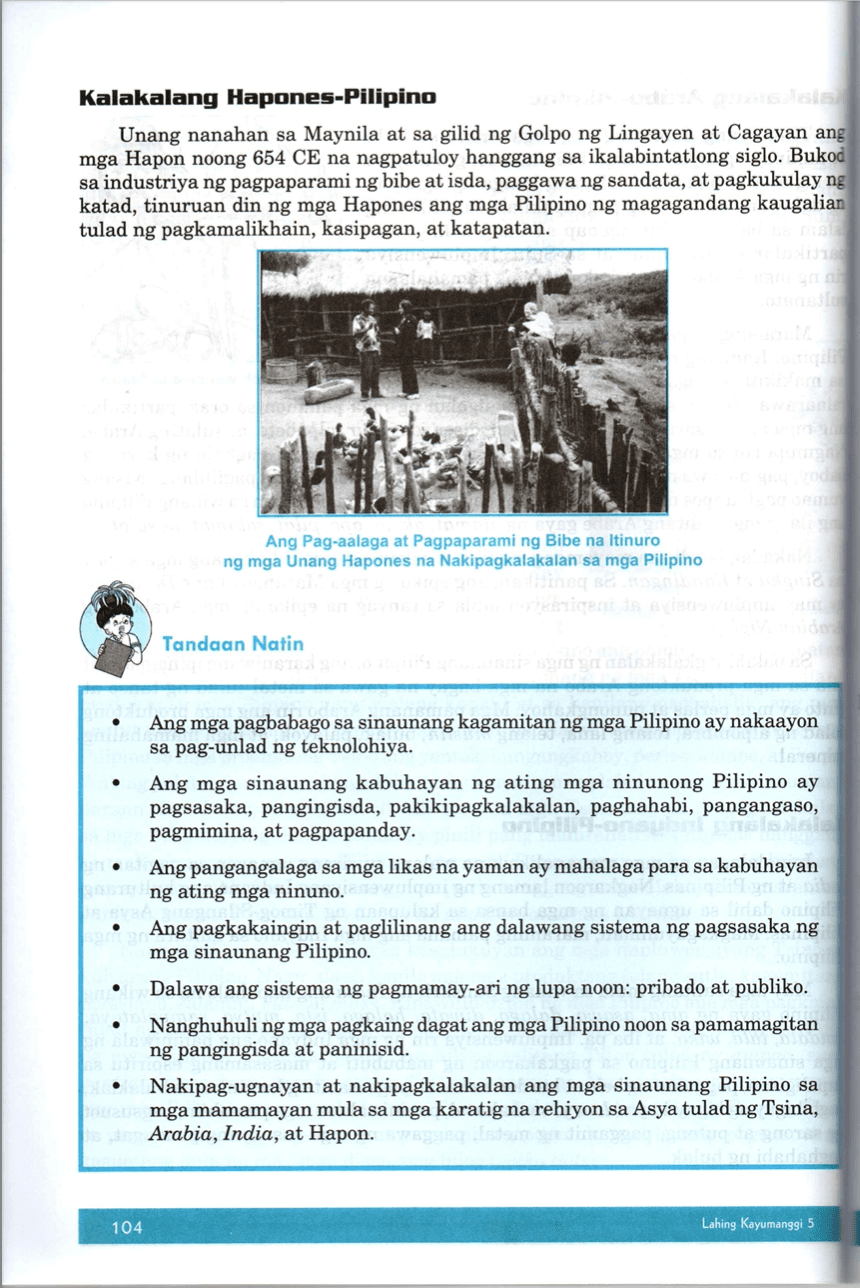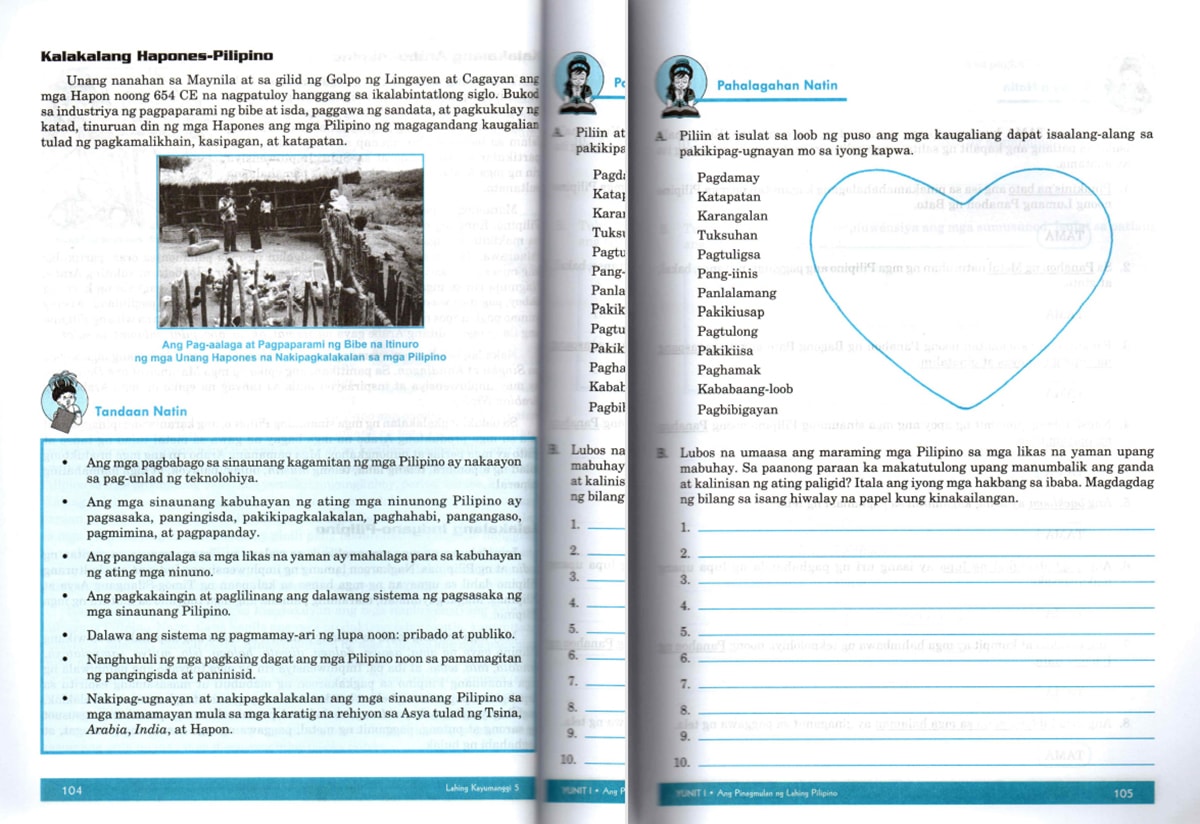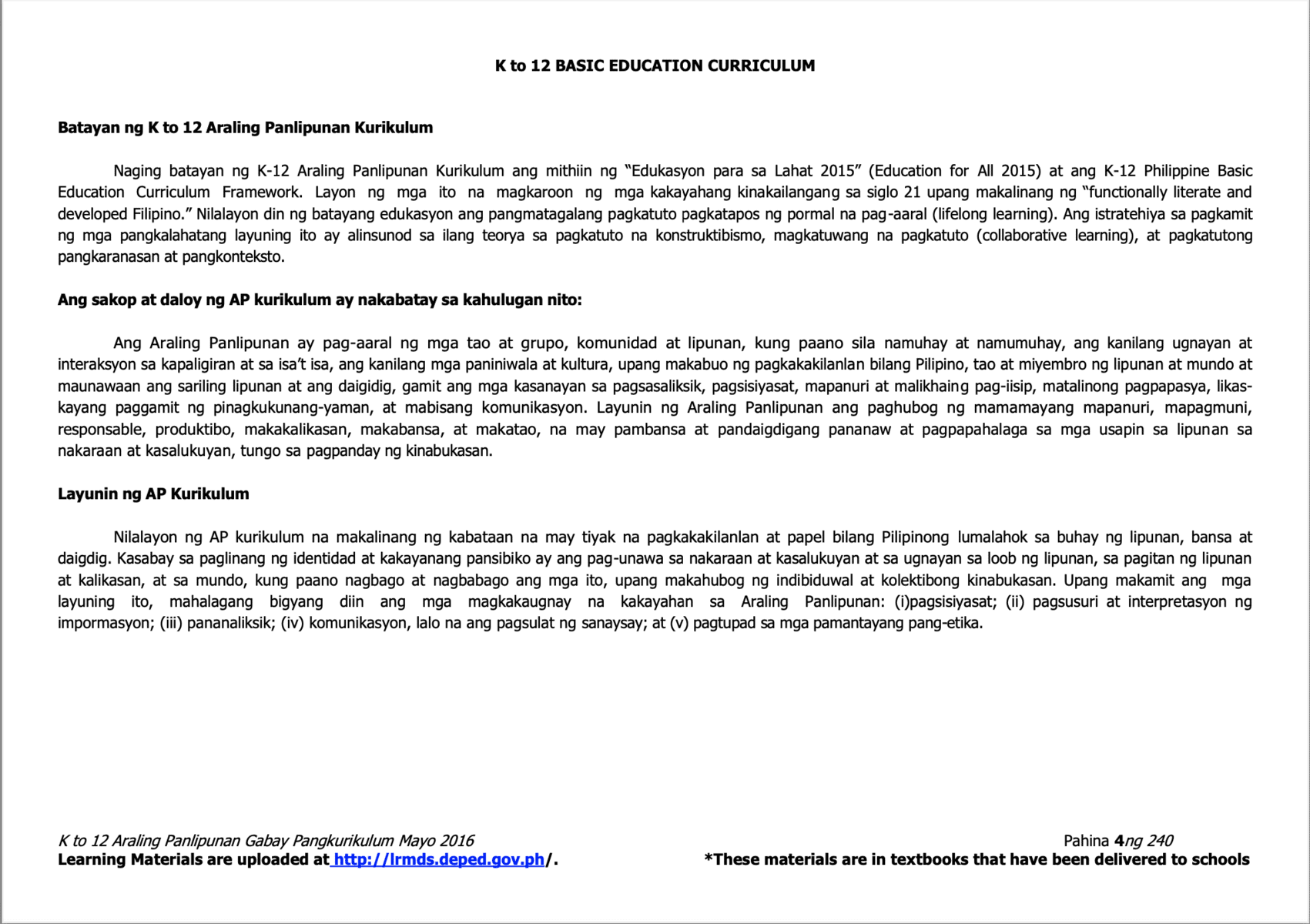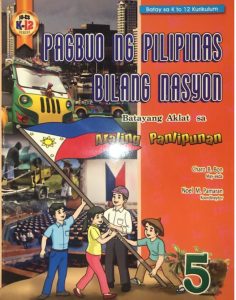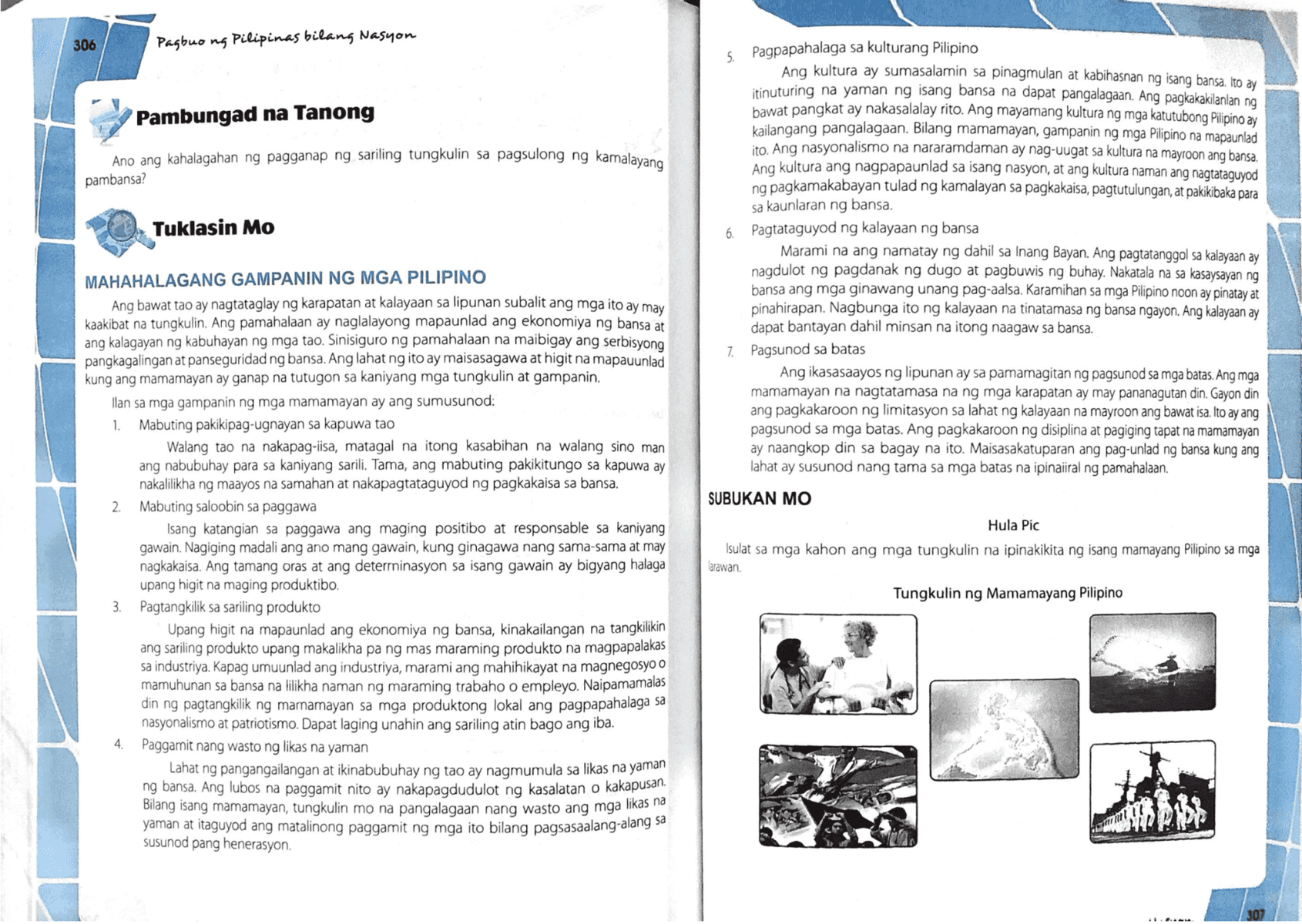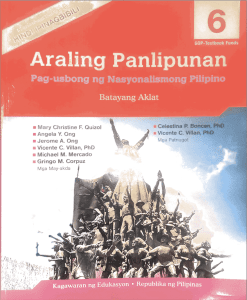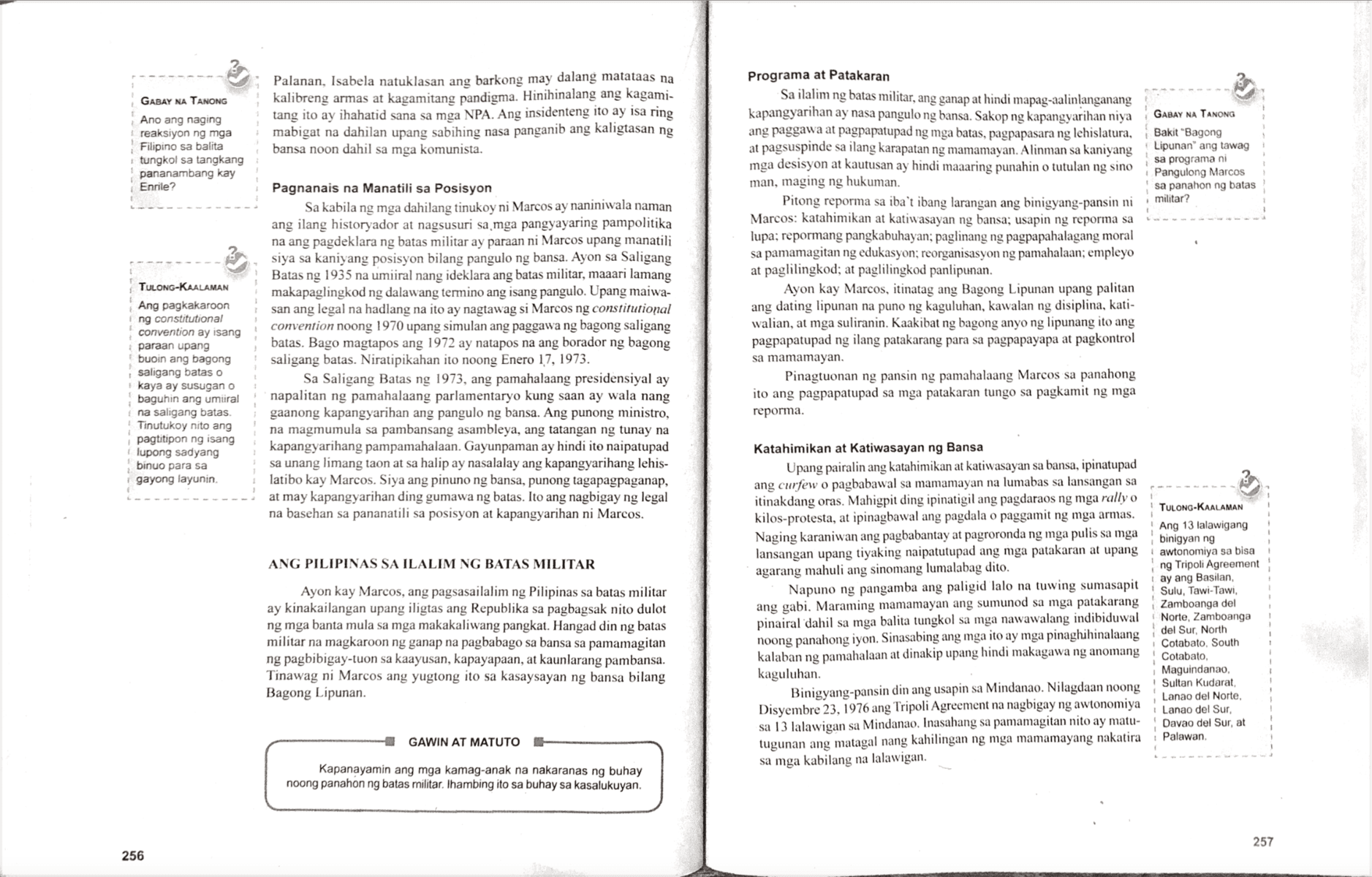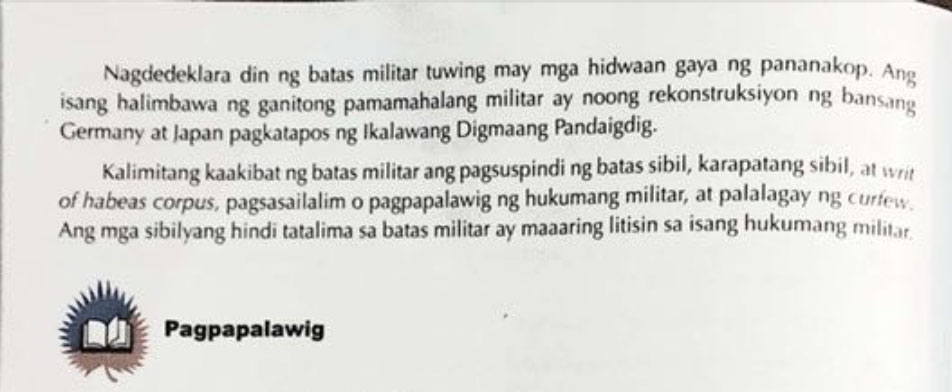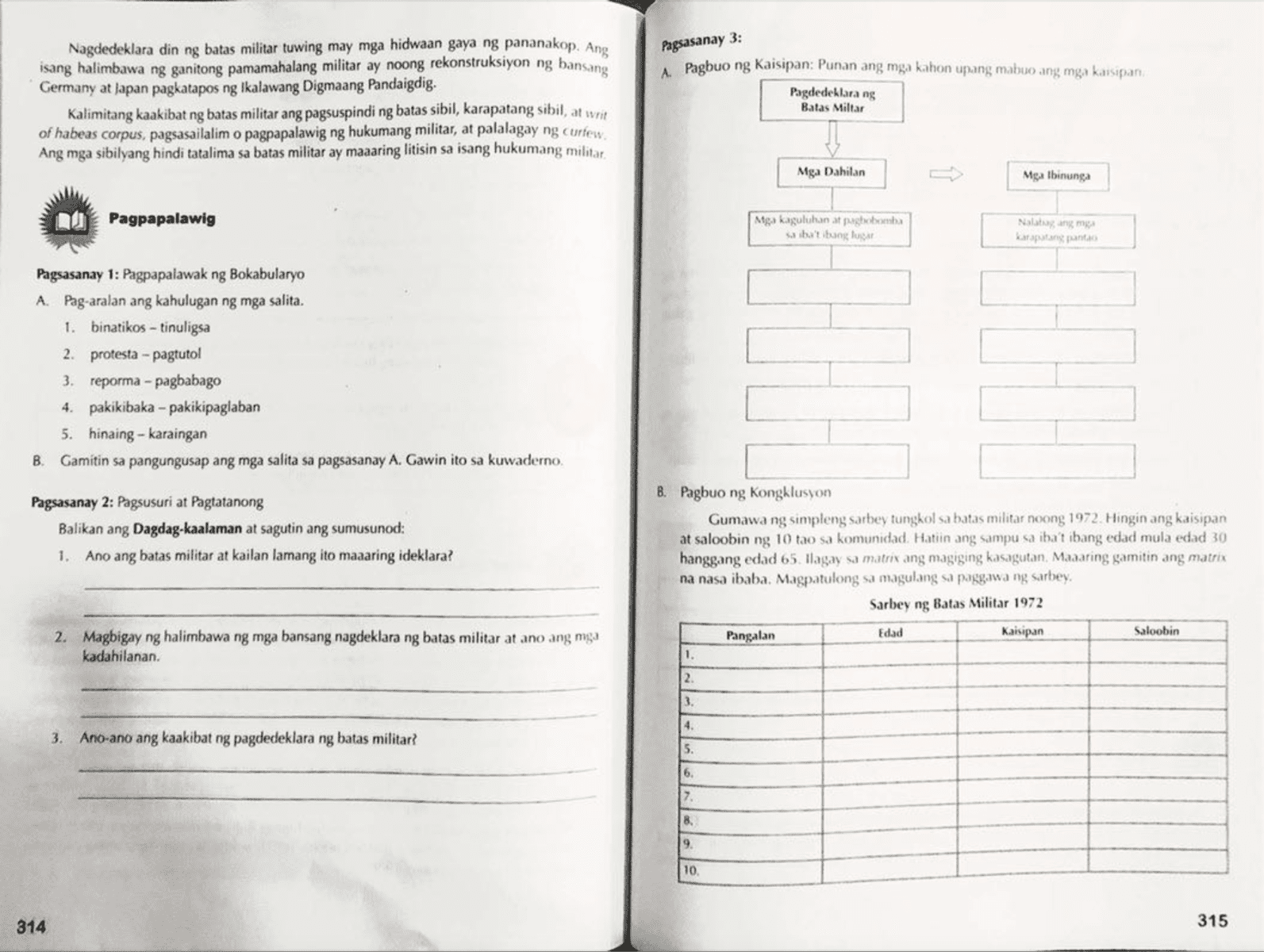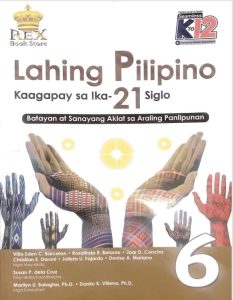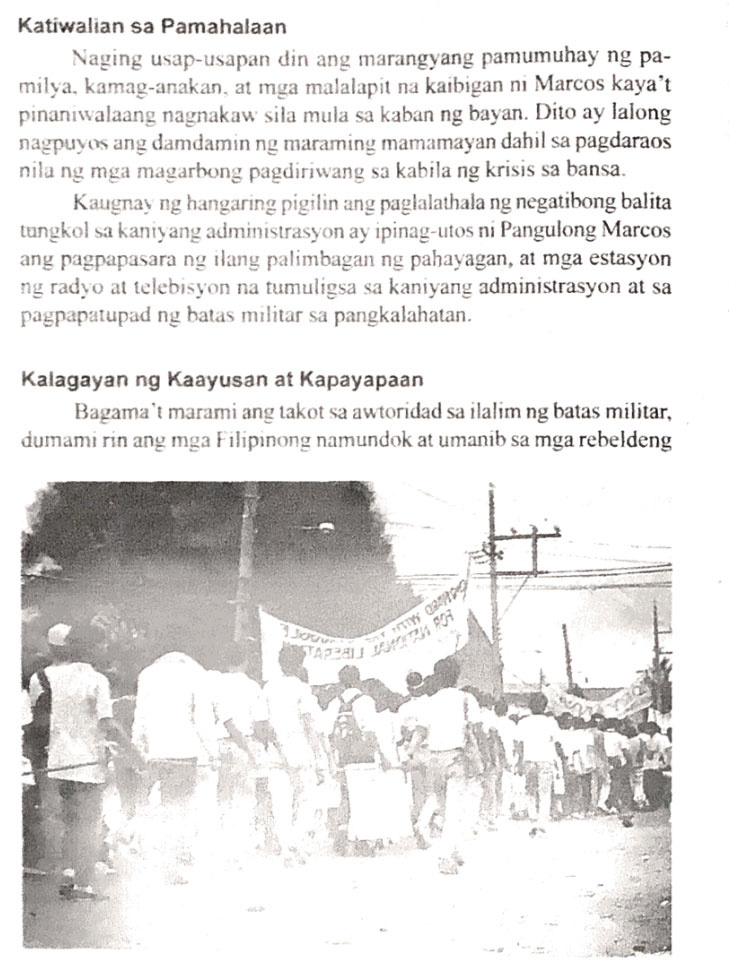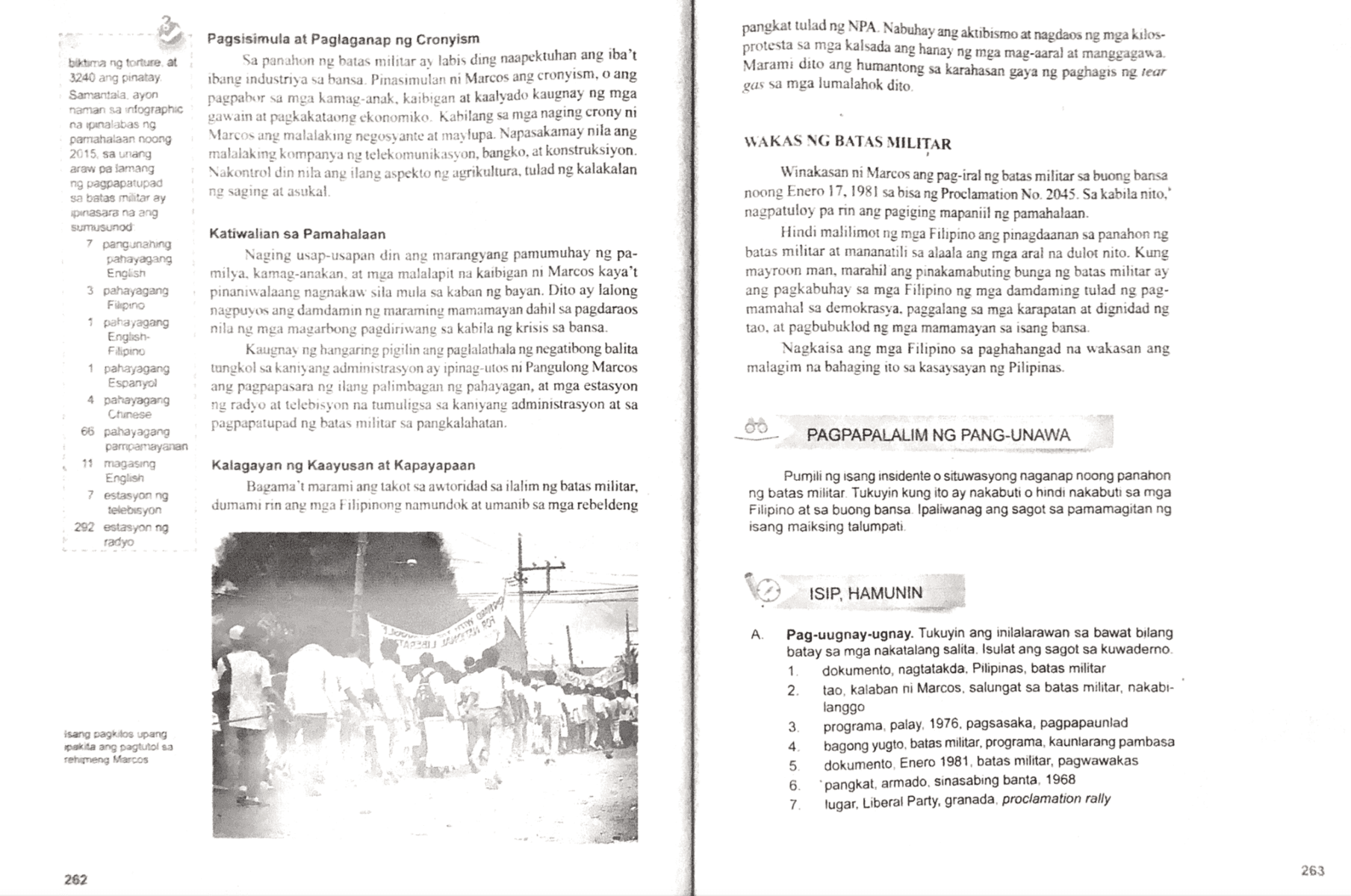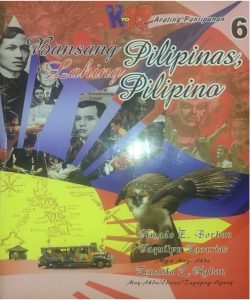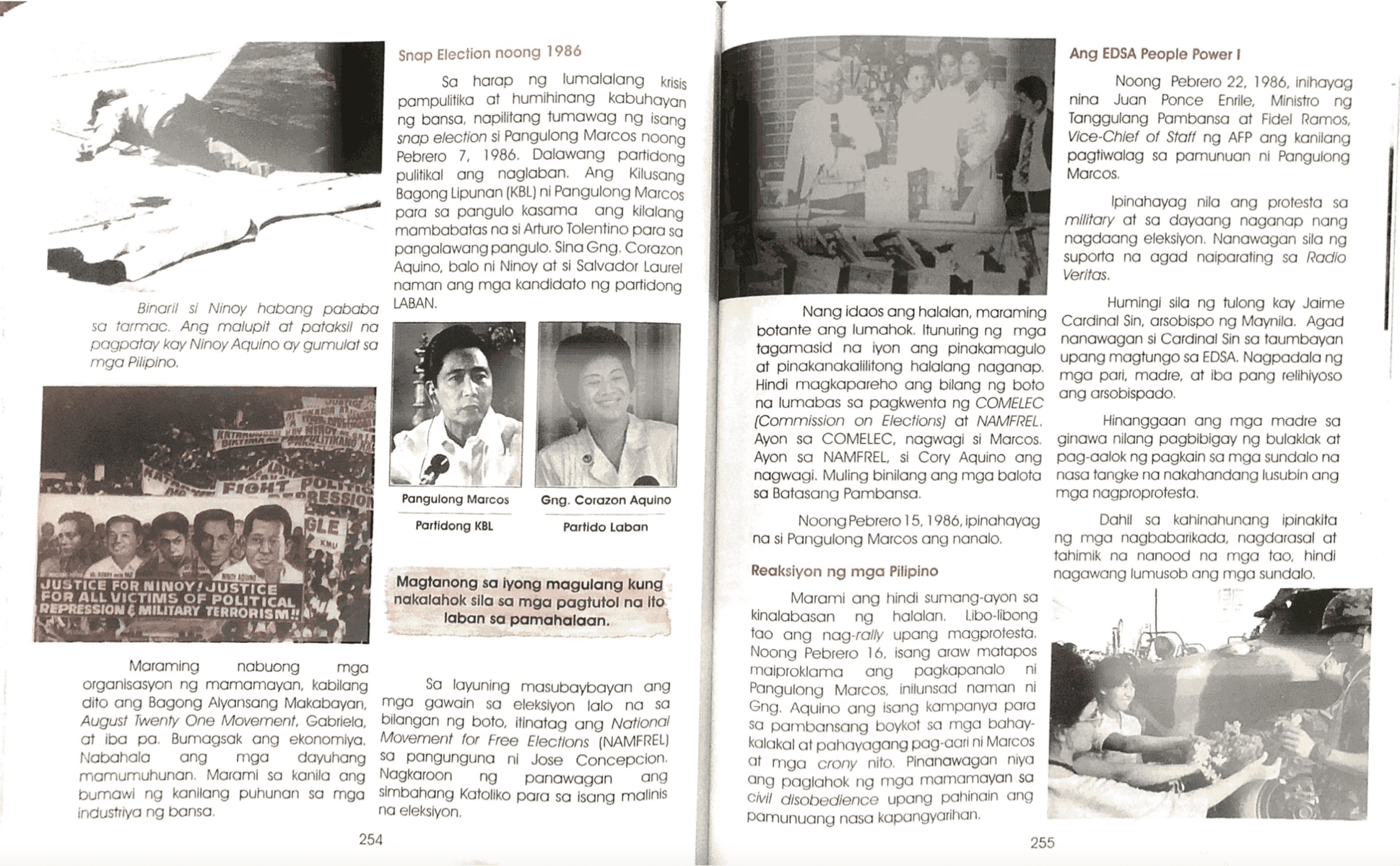The Dilemma of Philippine History
Textbooks
by
Maria Serena I. Diokno, Ph.D.
Kerby C. Alvarez, Ph.D.
Francisco Jayme Paolo A. Guiang
Dondy Pepito II G. Ramos
Aaron F. Viernes
A Review of Select
Grades 5 and 6
Araling Panlipunan Textbooks
Introduction
The social studies textbook is typically seen as a factual narration of history containing significant and accurate historical information that is organized chronologically, and then thematically. Because the Philippine textbooks are based on the Araling Panlipunan curriculum prescribed by the Department of Education (DepEd), it is also presumed that textbooks prescribe what should be learned (and need not be learned) in class. In general, textbooks are written with an authoritative tone, which helps reinforce the factuality and correctness of the information presented. And since textbook authors are invisible (“the textbook says” is the typical statement, rather than the “textbook author says”), the perception is strengthened that social studies textbooks are free of perspective, interpretation, and bias.
Widely believed as they are, these assumptions do not frequently hold true. Historical content is not free of perspective. The content does not write itself. It is selected for not everything that happened can be covered by the textbook. The organization and emphasis of historical information are the product of not only the author’s prior factual knowledge of Philippine history, but also an understanding of what is (and is not) significant. Textbook writers, moreover, interpret facts expressly or impliedly. Whether or not they amply support their interpretations is, of course, another (and important) matter.
In the Philippines textbooks are of immense importance because they are the primary, in most instances, the sole, learning resource. The FEU Public Policy Center, which seeks to contribute substantively to policymaking, formed a project to review the Araling Panlipunan textbooks especially in light of the ongoing climate of mis/disinformation, historical distortions floated in the public arena, and concerns about the youth’s understanding of Philippine history. The review team, led by UP Prof. Emeritus Maria Serena I. Diokno, and composed of her History Department colleagues, Dr. Kerby C. Alvarez, Francisco Jayme Paolo A. Guiang, Dondy Pepito G. Ramos II, and Aaron F. Viernes, examined the Araling Panlipunan textbooks of Grades 5 and 6, as Philippine history is taught in these grades. The textbooks were published from 2016 to 2019 and are used in selected private and in all public elementary schools. The overall aim of the review is to improve the teaching and learning of social studies.
The textbooks that were reviewed, fourteen in all, are as follows.
School
Grade 5
Maire Fe P. Bosales and Amado E. Borbon, Lahing Kayumanggi: Pagbuo ng Pilipinas Bilang Nasyon (The Library Publishing House, Inc., 2017).
Grade 6
Mary Joy P. Torres, et. al., Lahing Kayumanggi: Mga Hamon at Tugon sa Pagkabansa (Quezon City: The Library Publishing House, Inc., 2017).
School
Grade 5
Charo B. Bon and Noel M. Pamaran (coordinator), Pagbuo ng Pilipinas Bilang Nasyon (Valenzuela City: Jo-Es at Tugon sa Pagkabansa Publishing House, Inc., (Jo-Es, 2016).
Grade 6
Jay Son C. Batang and Noel M. Pamaran (coordinator), Kronika: Mga Hamon at Tugon sa Pagkabansa (Valenzuela City: Jo-Es Publishing, 2016).
School
Grade 5
Maria Annalyn P. Gabuat, Michael M. Mercado, Mary Dorothy dL. Jose, and Celestina P. Boncan and Vicente C. Villan (editors), Araling Panlipunan: Pilipinas Bilang Isang Bansa (QC: Vibal Foundation, 2016).
Grade 6
Mary Christine F. Quizol, Angela Y. Ong, Jerome A. Ong, Michael M. Mercado, Gringo M. Corpuz, and Vicente C. Villan and Celestina P. Boncan (coordinators), Araling Panlipunan: Pag-usbong ng Nasyonalismong Pilipino (QC: Vibal Group, Inc., 2016).
School
Grade 5
Lydia N. Agno, Rosita D. Tadena, Celinia E. Balonso, and Marvie M. dela Cruz, Kultura, Kasaysayan, at Kabuhayan (QC: Vibal Foundation, 2016).
Grade 6
Lydia N. Agno, Rosita D. Tadena, Celinia E. Balonso, and Marvie M. dela Cruz, Kultura, Kasaysayan, at Kabuhayan (QC: Vibal Foundation, 2016).
School
Grade 5
Irwin II E. Edillor and Jose A. Alcala, Pilipinas sa Makabagong Mundo (FNB Educational, Inc., 2018).
Grade 6
Jose A. Alcala, and Edna B. Oxales, Pilipinas sa Makabagong Mundo (FNB Educational, Inc., 2018).
School
Grade 5
Julieta U. Fajardo, Rosalinda R. Belarde, Villa Eden C. Barcelon, Christian E. Daroni, and Susan P. dela Cruz (coordinator), and Marilyn U. Balagtas and Danilo K. Villena (consultants), Lahing Pilipino: Kaagapay sa Ika-21 Siglo (Manila: Rex Book Store, 2019).
Grade 6
Villa Eden C. Barcelon, Rosalinda R. Belarde, Joar D. Concha, Christian E. Daroni, Julieta U. Fajardo, Denise A. Mariano, and Susan P. dela Cruz (coordinator), and Marilyn U. Balagtas and Danilo K. Villena (consultants), Lahing Pilipino: Kaagapay sa Ika-21 Siglo (Manila: Rex Book Store, 2019).
School
Grade 5
Leo Jachin S. Labadnoy, Jaquilyn Zacarias, and Zenaida Z. Agbon (coordinator), Bansang Pilipinas, Lahing Pilipino (QC: Ephesians Publishing, 2015).
Grade 6
Amado E. Borbon, Jacquilyn Zacarias, and Zenaida Z. Agbon (editor and coordinator), Bansang Pilipinas, Lahing Pilipino (QC: Ephesians Publishing Inc., 2017).
The textbooks present a linear history of the Philippines from the earliest (pre-colonial) period to the present. Grade 5 ends in 1815, at which point Grade 6 begins and continues until the contemporary period.
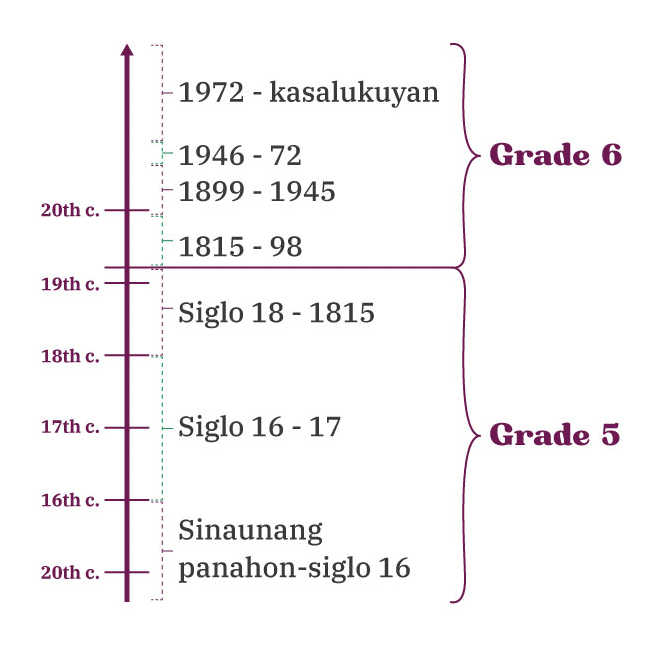
Within these time frames, events are organized thematically (e.g. Christianization and resettlement of Filipino communities in the 16th and 17th centuries, early uprisings against Spanish rule), although the themes are not evenly discussed. Philippine History from 1815 onward tends to focus on political aspects and events (e.g. Philippine Revolution, war against the United States, World War II).
The foundation story of Philippine history that emerges from the textbooks is the history of our struggle to build a free and democratic society. Discussions revolve around cycles of colonization and resistance, the struggle for independence and self-rule, and socio-political milestones. Below are summary descriptions of each time period.
Sinaunang panahon-siglo 16
Mayroong natatangi at mayamang kultura ang Pilipinas, tradisyong pampulitika, at malawak na pakikipag-ugnayan sa mga karatig lugar sa Asya.
Siglo 16-17
Nagdulot ang hispanisasyon ng mahahalagang pagbabago: pagkalat ng Kristiyanismo, pagbabago sa pamayanan, pagmamay-ari ng lupa, at kabuhayan sa ilalim ng mga patakarang kolonyal.
Siglo 18-1815
Nagtangkang sakupin ng Espanya ang mga katutubong komunidad sa hilaga at timog Pilipinas. Sa bandang hulihan ng ika-18 dantaon ay naglunsad ng reporma sa ekonomiyang kolonyal sa gitna ng patuloy na pag-aalsa ng mga Pilipino.
Siglo 1815-1898
Lumahok ang Pilipinas sa pandaigdigang kalakalan nang tumigil ang kalakalang galyon. Nahubog ang konsepto ng pagkabansang Pilipino at natapos ang siglo sa malawakang himagsikan para sa kalayaan ng Pilipinas bilang bansang nagsasarili.
1899-1945
Matapos ang digmaang Pilipino-Amerikano, sinimulan ng Estados Unidos ang makabagong debelopment sa pamamahala, edukasyon, kalakalan at imprastruktura, at patuloy na nagpunyagi ang mga Pilipino para sa lubusang kalayaan hanggang sa WWII.
1946-1972
Matindi ang mga hamong panlabas at panloob sa bagong republika (mga hindi patas na kasunduan ng Pilipinas-E.U., rebelyong Huk at suliraning pang-agraryo), na hinarap ng bawat administrasyon mula kay Roxas hanggang Marcos.
1972-kasalukuyan
Tinaob ng batas militar ang demokrasya at ipinagibayo ng mga Pilipino ang paglaban para sa isang malaya at masiglang demokrasya sa gitna ng mga kontemporaryong usapin katulad ng globalisasyon, migrasyon (OFW), at climate change.
The narrative of the struggle for freedom is historically apt. Pedagogically, this means that at the end of the school year, the student should be able to understand and explain what it means to be free, and what it means to be a Filipino nation. These outcomes, however, are not apparent in the textbooks, i.e., they are not discussed consistently as the overarching historical frame. The problem, to borrow Dr. Samuel Wineburg’s words, is that the textbooks’ focus on facts obfuscates “the grand narrative of history.”1 Cited in Catherine Gewertz, “History Lessons Blend Content Knowledge, Literacy,” 30 July 2012 https://www.edweek.org/teaching-learning/history-lessons-blend-content-knowledge-literacy/2012/07.
The textbooks’ grand narrative of Philippine history, in addition, is but ought not to be dominantly political in content for the making of the nation was a composite of many (and complex) elements and should be understood not just from a political standpoint. In this report, the review team makes specific recommendations on improving the content of the textbooks.
Part II:
Historical Inaccuracies
Teachers and students rely heavily on textbooks. It is therefore imperative that facts that are presented are accurate and authors’ interpretations are grounded in evidence. In this version of the report, we present several examples of factual inaccuracies, including unproven statements that are presented as facts.
The first consists of statements that attribute Filipino traits to the Spanish, American, and Japanese colonizers. Not only are these claims presented as facts; they also assign historical agency to foreign rulers, denying Filipinos a role in the development of their own culture. In history no change takes place without agency; and historical actors (agents) must be proven, not assumed. One textbook maintains that a whole range of dispositions and practices, from the “bahala na” mentality and the “mañana” habit to pride or amor propio, the inability to refuse a request, and the propensity for a luxurious lifestyle, are all attitudes we acquired from Spain. Another group of textbook authors trace Filipino diligence, creativity, and loyalty to the Japanese.
As for factual errors, the team found them among easily verifiable dates, names, and events, which students are often asked to memorize. For example:
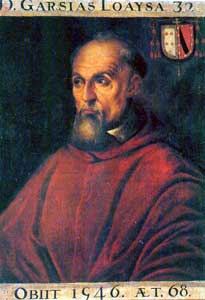
Juan Garcia Loaysa
Author: http://personal.us.es/alporu/Images/sevillahist/arzob_garcialoaysa.jpg
Created: 16th century
The 1525 Loaísa expedition was headed by “Francisco de Loaisa;” after the death of Loaísa, the expedition was taken over by “Sebastian Cabot.” (Labadnoy et. al., Bansang Pilipinas, Lahing Pilipino, 172)
García Jofre de Loaísa headed the 1525 expedition (not Francisco de Loaísa), and Sebastián Elcano took over after his death (not Sebastián Cabot).

Manila-Acapulco Galleon Trade
Author: Boxer Codex (1590) – Unknown Spanish Author/Compiler with Likely Chinese Artist from Spanish Colonial Manila, Philippines, circa 1590 AD
Created: 1 January 1590
“Ang Compañia Real o Real Compañia de Filipinas ang nangangasiwa sa Kalakalang Galyon o ang pamimili at pagluluwas ng mga produkto sa pagitan ng Mehiko at Pilipinas.” (Bosales and Milambiling, Lahing Kayumanggi: Pagbuo ng Pilipinas Bilang Nasyon, 305)
The Manila-Acapulco galleon trade was separate from the Royal Philippine Company. The latter was, in fact, formed to conduct trade between the Philippine colony and Spain without crossing the Pacific.
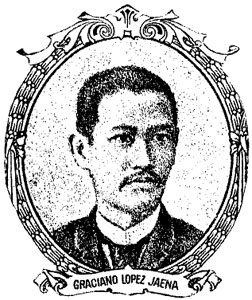
Graciano Lopez Jaena
Description Image from the book “Mga Dakilang Pilipino” by Jose N. Sevilla
Date 1922
Source: http://www.gutenberg.org/files/17786/17786-h/17786-h.htm
Author Jose N. Sevilla
“Si Graciano Lopez Jaena ay namatay sa Europa noong Enero 1890 at si Juan Luna noong Hulyo 4, 1890.” (Oxales and Alcala, Pilipinas sa Makabagong Mundo, 58.)
Graciano Lopez Jaena died on 20 January 1896 (not 1890), and Juan Luna, on 7 December 1899 (not 4 July 1890).

Andres Bonifacio
Author: Chofre y Cia (now Cacho Hermanos Inc.)
Created: 1 January 1896
“Andres Bonifacio: Nakilala bilang Supremo ng KKK, isa siya sa mga nanguna at namuno ng Himagsikan ng 1896. Pinamunuan niya ang sangay na Magdiwang ng nakaposisyon sa Hilagang Katagalugan.” (Barcelon et. al., Lahing Pilipino: Kaagapay sa Ika-21 Siglo, 86.)
Andres Bonifacio did not lead the Magdiwang and the latter was a chapter in Cavite, not in northern Luzon.
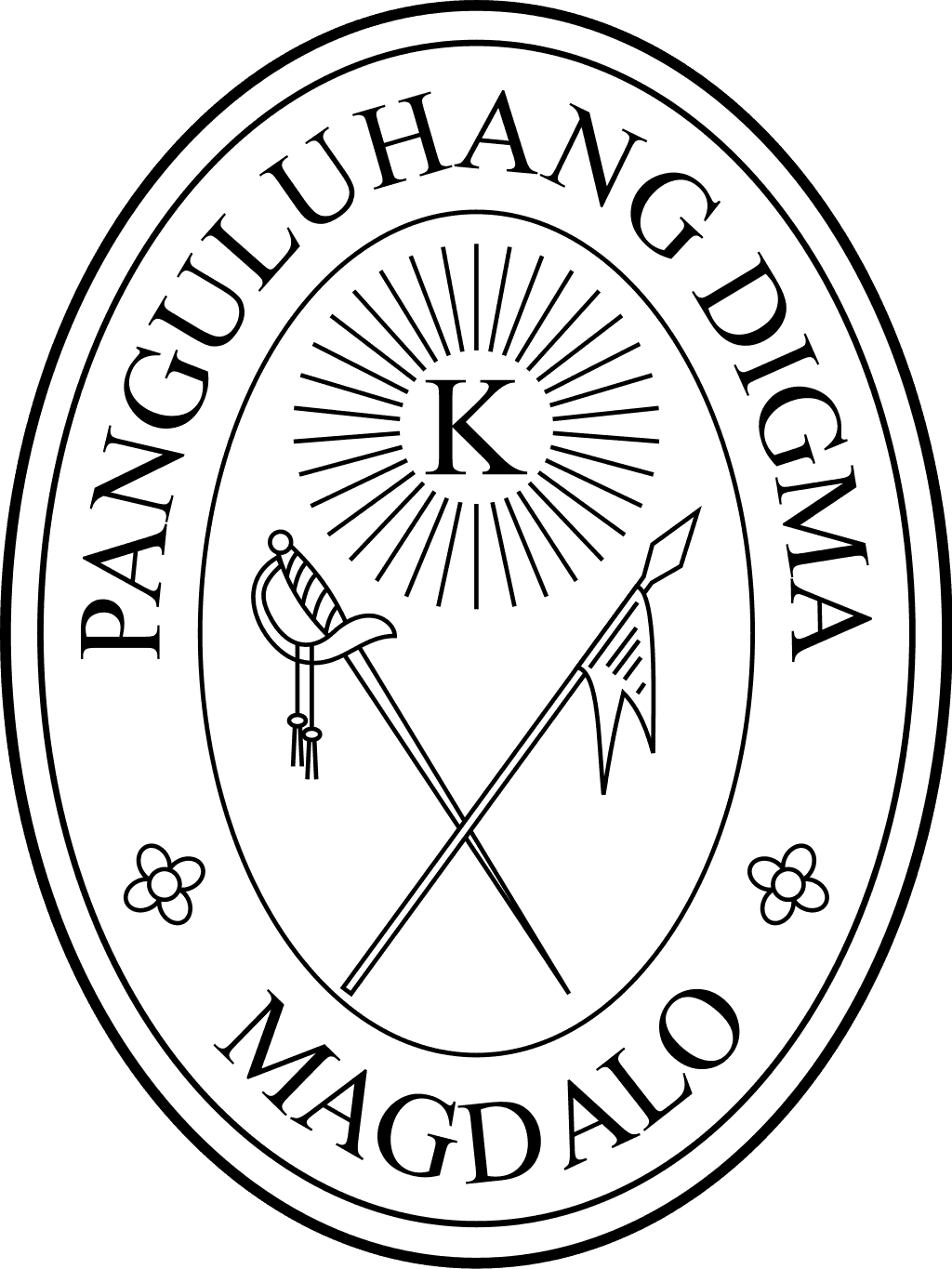
Magdalo Chapter
Author: J-Ronn – Official Gazette of the Philippines – Araw ng Republikang Filipino
Created: 27 April 2016
“Siya [Emilio Aguinaldo] ang naging pinuno ng pangkat na Magdalo, ang konseho ng mga Katipunero sa Cavite.” (Torres, et. al., Lahing Kayumanggi: Mga Hamon at Tugon sa Pagkabansa, 55)
Baldomero Aguinaldo headed the Magdalo faction, not his cousin Emilio. Also, Magdalo was one of two provincial councils of the Katipunan in Cavite.
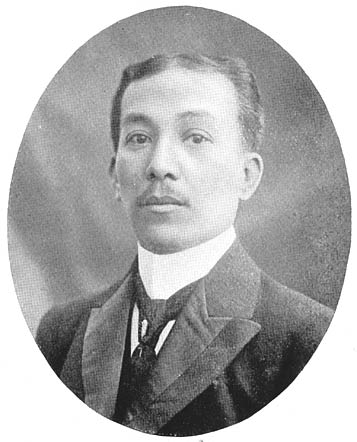
Felipe Agoncillo
Author: Project Gutenberg ebook of The Philippine Islands
Created: circa 1905
“Hindi naglaon, bumalik siya [Felipe Agoncillo] sa Pilipinas na matagumpay. Nakuha niya ang pagkilala ng ibang bansa sa bagong republika.” (Alcala and Oxales, Pilipinas sa Makabagong Mundo, 79)
Felipe Agoncillo, the official representative of the Philippine government, was not successful in gaining the formal recognition of any foreign country.
It appears that the textbooks did not undergo a rigorous review process.
Part III:
Civic Goals
Civic education is a cornerstone of the Araling Panlipunan curriculum, which aims to develop responsible citizens with a clear identity as Filipinos.
Two methods are used to teach civic mindedness: prescriptions, which students are to imbibe in their personal lives, and class activities intended to demonstrate the students’ civic orientation. Prescriptions state the desired conduct and traits expected of students as Filipinos and Filipino citizens, and are often worded using mandatory language (“dapat”), while activities are usually contextualized in different scenarios that deal with historical events or current concerns such as cultural pride, environmental consciousness, gender equality, and patriotism.
Among the topics taken up in prescriptive statements are good social relations, proper work ethics, patronage of local products, responsible use of natural resources, allegiance to the republic and the national flag, and compliance with the law. The emphasis here is the responsibility or duty of the good student (citizen).
Civic rights, on the other hand, do not figure as prominently in prescriptive statements but rather in activities at the end the chapter. Many of the activities are situational and try to draw out student responses and opinions.
The textbooks also link active citizenship and civic rights with fundamental tenets of a democracy, such as the accountability of public officials, protection of the environment, defense of the country’s sovereignty, nationalism, and advocacy of freedom of speech and other rights.
One can hardly argue with the civic prescriptions as these are motherhood statements. The more important question is, are such prescriptions the most effective way to teach civics? The prescriptions are repetitive, and their very nature (mandatory) leaves little room for discussion especially of difficult scenarios in today’s world. Civic prescriptions in the textbooks also tend to appeal to emotion or public sentiment than to civic knowledge (such as how government works or ought to work, voter registration, basic tenets of the constitution). We all know that the duties, rights, and values of citizenship blur when situated in imperfect and worse, corrupt and inefficient systems and processes of government. Vote-buying, for example, is often explained today in terms of the poor voter’s next meal. How would a class in civics approach this dilemma?
A prescriptive approach could also preempt discussion because students are likely to echo the prescription in their answer; or leave discussions open-ended as expressions of individual opinions, with little or no attempt to tease out learning moments from the discussion, juxtapose contrasting views, or even try to resolve them. The instruction in one teacher’s manual advises the instructor to just let the students state their opinion.2 Lucila De Guzman, Pilipinas sa Makabagong Mundo: Isang Hamon, Quezon City: FNB Educational, Inc., 2018.
Lastly, the assessment of student responses poses a problem because students will likely affirm what the textbook says, especially if the statement bears the word “should” or “must.” Few would risk being labeled unpatriotic or irresponsible.
Part IV:
About Martial Law
About Martial Law
Martial law is a significant event in the social studies curriculum and textbook. The year 1972, when martial law was declared, serves as the event that divides contemporary Philippine history (postwar and post-independence) into two. The use of this event to delineate one period from the next suggests a radical departure from what was to something different or striking. Yet the treatment of martial law ranges from only 7% to 11% of the total number of pages in the Grade 6 textbook. Moreover, given the overall textbook narrative of the Filipino struggle for freedom and nationhood, martial law occupies a relatively limited space.
The question is often asked, how is martial law taught in social studies? The answers differ according to the textbook. One, for instance, regards martial law favorably.3 Edna B. Alcala and Jose A. Oxales (ed.), Pilipinas sa Makabagong Mundo (QC: FNB Educational, Inc.), 311. Its authors enumerate the programs of martial law exactly as they are officially written (the “PLEDGES”), which another textbook asks the students to give examples of in an exercise.4 Villa Eden C. Barcelon, Rosalinda R. Belarde, Joar Concha, Christian Daroni, Julieta U. Fajardo, Denise Mariano, and Susan P. dela Cruz (coord.), and Marilyn U. Balagtas and Danilo K. Villena (consultants), Lahing Pilipino Kaagapay sa ika-21 Siglo (Manila: Rex Book Store, 2019), 313. Among the achievements cited are unproven claims that the authors present as facts, namely:
- “Binuhay ang diwa ng pagiging makabayan ng mga Pilipino sa pamamagitan ng islogang ‘Isang Bansa, Isang Diwa’;”
- “Sinanay ang mga Pilipino na maging masunurin at disiplinado.”5 Alcala and Oxales, 311.
The rest of the textbooks are uneven in their treatment of martial law. There are obvious silences, such as the acquisition of illegal wealth by Mr. Marcos and family, and less obvious silences masked by efforts to appear objective. Let us start with the explanation of why martial law was declared.
The textbooks echo Mr. Marcos’s justification of martial law: the threat of communism and rising disorder in society (crime and drug use).
- All seven textbooks cite public protests that were taking place against oil price hikes.
- Six out of seven cite the Plaza Miranda bombing as another reason.6 Only Alcala & Oxales did not cite Plaza Miranda bombing as another reason.
- Four of seven mention the “Mindanao problem” and the “ambush” of then Defense Secretary Juan Ponce Enrile.7 Lydia N. Agno. Rosita D. Tadena, Celinia E. Balonso, Marvie M. dela Cruz, Kultura, Kasaysayan, at Kabuhayan (QC: Vibal Foundation, Inc., 2918), 291; Jay Son C. Batang and Noel M. Pamaran (coordinator), Kronika: Mga Hamon at Tugon sa Pagkabansa (Valenzuela City: Jo-Es Publishing House, Inc.,2016), 283; Amado E. Borbon, Jacquilyn Zacarias, and Zenaida Z. Agbon (ed. and coord.), Bansang Pilipinas Lahing Pilipino, (QC: Ephesians Publishing Inc., 2017), 233; Mary Christine F. Quizol, Angela Y. Ong, Michale M. Mercado, Gringo M. Corpuz, and Vicente C. Villan and Celestina P. Boncan (cords.), Araling Panlipunan: Pag-usbong ng Nasyonalismong Pilipino (QC: Vibal Group, Inc., 2016), 255.
- Two mention Senator Ninoy Aquino’s exposure of Oplan Sagittarius, a planned series of bombings to be blamed on communists so as to justify Marcos’s declaration of martial law.8 Batang and Pamaran, 283; Mary Joy P. Torres, Ruben Milambiling (coord.), and Rowel M. Fulgar (ed.), Lahing Kayumanggi: Mga Hamon at Tugon sa Pagkabansa (QC: The Library Publishing House, Inc., 2017), 237.
But only two refer to Marcos’s ambition to remain in power beyond his term, although they present this reason not as their own (in contrast to the reasons above), but rather as the viewpoint of “some” (unnamed) historians (“paningin ng mga historyador”). By these means the authors avoid taking a position, a device that is used to appear fair or neutral. As for the “Enrile ambush,” four textbooks cite the event but two of them treat it as fake.9 Agno et al., 233. The other two do not question the veracity of the event.10 Batang and Pamaran, 283; Quizol et al., 255.
There are degrees of silence on various other aspects of martial law. In history writing, silence is, as historian Michel-Rolph Trouillot explains, active, not passive,11 Michel-Rolph Trouillot, Silencing the Past: Power and the Production of History (Boston: Beacon Press, 1995), 48. and results in a history that is partial, contrary to the claim of textbook impartiality. What is not mentioned is as significant as what is. And so the silences speak loudly. Here are examples.
1. 1973 Constitution
- One textbook does not even mention the new constitution.12 Barcelon et al.
- Two mention the constitution (in two to four sentences).13 Agno et al., 314.
- Two explain it briefly, and two others explain it adequately.14 Borbon et. al., 252 and Batang and Pamaran, 284, explain the 1973 constitution briefly, while Quizol et al., 256 and Torres et al., 237, explain it adequately.
The ratification of the constitution speaks to the nature of martial law. Instead of individual voters deciding on the constitution, “citizens assemblies” were installed with no identification and verification of its members. Ratification was done by viva voce or open show of hands, and there were reports of assemblies being asked to answer questions totally unrelated to the constitution. Yet five textbooks are entirely silent about this unusual and questionable manner of ratification.15 Agno et al.; Barcelon et al.; and Borbon et. al. Of the remaining two, one mentions the citizens assemblies but does not examine it,16 Torres et al., 237. while the other does.17 Alcala and Oxales, 314.
2. Programs of martial law
- Two textbooks adopt the New Society programs (using the acronym, PLEDGES), with no explanation beyond what the government wrote, and no discussion of the cost and impact of the programs.18 Barcelon et al., 236-37; Borbon et. al., 233.
- One textbook, as mentioned earlier, assesses these programs positively, without providing any basis for the assessment.19 Alcala and Oxales, 311.
- Four textbooks provide a critical assessment of the programs of martial law,20 Agno et al., 296; Batang and Pamaran, 285; Quizol et al., 260.; Torres et al., 240. citing the imprisonment of critics of martial law, the takeover of media and broadcasting companies, and state-sanctioned human rights violations as among the harmful effects of martial law. Here at least some proof is provided, such as Gen. Order No. 1, which so empowered the president as to give him control of the entire government. Persons who were unlawfully arrested are also named and described in some of the textbooks.
Most of the textbooks, moreover, agree that Marcos’s martial law was authoritarian in nature, about which evidence abounds. The textbooks could be improved by providing more evidence. One, for example, lifts the explanation of the deleterious effects of martial law directly from Wikipedia and translates it into Filipino without any acknowledgement of the source.21 Martial Law in the Philippines, link: https://en.wikipedia.org/wiki/Martial_law_in_the_Philippines
3. Lifting of martial law (Proclamation No. 2045, 17 January 1981) What exactly did ‘lifting’ martial law mean? Did Mr. Marcos’s expansive powers end with his proclamation?
- Two textbooks claim that martial law came to an end in 1981, but ignore the fact that Marcos remained powerful, based on his own proclamation.22 Borbon et. al., 252; Torres et al., 253.
- The other textbooks agree that martial law was not actually lifted in practice, but only two of them cite evidence to support this position.23 Agno et al., 317 and Quizol et al., 263, agree that martial law was not lifted in practice but do not provide evidence. Alcala and Oxales, 321 and Batang and Pamaran, 286, cite evidence to support their argument.
4. Plunder of national coffers
- Only one textbook out of seven mentions Marcos’s ill gotten wealth and does so tentatively (“naging usap-usapan”)24 Quizol et al., 262. despite the evidence, which includes Supreme Court and Sandiganbayan decisions.
- Five textbooks briefly discuss acts of corruption by the Marcos cronies, but not by Mr. Marcos himself and his family.25 Alcala and Oxales; Barcelon et al.; Batang and Pamaran; Borbon et. al.; Torres et al.
- In a subsequent chapter, one textbook mentions (in two sentences) the establishment of the Presidential Commission on Good Governance as the government’s effort to recover plundered wealth. But the chapter on martial law does not take up the issue at all.26 Agno et al., 333.
5. Popular opposition to martial law and the People Power Revolution
Narratives about the opposition to authoritarian rule center on individuals (student leaders, cultural activists, and well known oppositionists)27 Quizol et al., 276-77. and less on the organizations and movements that figured prominently during the period, such as JAJA (Justice for Aquino, Justice for All), CORD (Coalition of Organizations for the Restoration of Democracy), and the National Alliance for Justice, Freedom and Democracy. References to armed underground movements are also few.
The textbook authors generally view the People Power Revolution as a positive development, an end to authoritarian rule, and a path to change. There is, too, a consensus among them that Sen. Ninoy Aquino’s assassination was the primary trigger in awakening public consciousness and mobilizing people to take protest actions. However, the textbook authors conflate the timeline of events leading to the revolution, such as the walkout of the staff of the Commission on Elections, the breakaway of Enrile and Fidel V. Ramos, and the call to action of Manila Archbishop Jaime Cardinal Sin, with the causes or factors that led to the mass action: the worsening state of the economy, Ninoy Aquino’s assassination, growing public awareness of official abuses, and the lack of credibility of the snap elections of February 1986.
Most disappointing is the treatment by the textbooks of the economic crisis, which most of them consider a crucial factor that led to the Edsa revolution. But they do not provide any economic data. Even the term “crisis” as used in the textbooks is not described in terms of data, thereby depriving students the opportunity to understand the meaning of an economic crisis and its impact in a given period of our history. The absence of economic data is also a grave historical omission for it perpetuates the myth of martial law as a prosperous, golden age in Philippine history.
The textbook authors attempt to appear objective (factual) and fair (by presenting both sides) in one or more of these ways: by being silent about significant facts; by hedging from taking a position when credible evidence exists and is readily accessible, and by treating the history of martial law as a matter of opinion or sentiment. Such attempts are misleading. There are facts about martial law, enough to take a position about the nature of martial law and its effects. Patent partiality, which is open and obvious, occupies one end of the spectrum of historical deception, while silence and “bothsidesism,” which are implicit and less easily perceptible, lie at the other. Bothsidesism assumes that the two sides of an issue are of equal value and are equally supported by evidence, when they are not always so.
For instance, textbook authors ask students to enumerate the ‘good’ and ‘bad’ features of martial law and then end with the enumeration.28 Agno et al., 289; Quizol et al., 263. But the serious learning part, reflecting on the lists produced by the students, is carefully avoided. Would the infrastructure program of martial law (often touted as an outstanding achievement) outweigh the denial of rights and grievous violations of human rights? Would a timid citizenry cowed by the dictatorial strictures of martial law be of greater value or good than the loss of their freedoms? If both sides are treated equally, then none gets dismissed even if one side is gravely objectionable. By avoiding the acknowledgment of wrongdoing in the face of reliable and overwhelming evidence of it, students are taught to ignore history and remain silent about issues of indubitably crucial significance. This runs contrary to the goals of Araling Panlipunan and certainly is not in keeping with the purposes and values of civic education. This, too, is a denial of our past.


